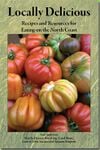
There is no standard definition, either in government or industry, for “local food.” To some, it means food grown within an arbitrary distance in miles. To a large U.S. corporation, it may mean food grown within the United States. But we do know that “local food” is a hot topic and that even the largest grocery chains are incorporating it into their marketing messages.
For this book, “local” means a natural biological region (bio-region) or foodshed that has the necessary active or potential food resources to sustain its population. Our natural bio-region is the area drained by our six rivers, called the Six Rivers Region. This roughly corresponds to Del Norte, Humboldt and Trinity Counties (Tri-County), or our core region. Our extended region pushes the boundaries to about 250 miles and includes the northern part of the Central Valley of California to the east, Sonoma County to the south, and Southern Oregon to the north. By including this extended region, we gain such foods as rice, olive oil and a few more great cheeses.
We currently supply only 8 to 15 percent of our food needs from our core region. As a comparison, in the first half of the 20th century we supplied 80 percent of our own food. The Tri-County area can supply each of our residents with more food than we need at about 3,000 calories per day. Clearly, we have the potential to feed ourselves.
Looking at food miles alone addresses the pollution and climate-changing effects of transporting food over great distances—industrial food travels an average of 1,500 miles from farm to fork—but it does not address the other negative impacts of industrial agriculture. To account for these impacts, our local food also needs to be grown in a sustainable way, free from the negative effects of excessive use of fertilizers, and the use of herbicides, pesticides, antibiotics and hormones.
The resources listed in the appendices cover the core region only—Del Norte, Humboldt and Trinity Counties—with a few exceptions that are noted. Recipes include foods from the core and extended regions, plus spices. We included spices because they are a long-standing part of culture and have been traded sustainably for centuries. They are not used in great volume, don’t weigh much, and thus can be produced non-locally.
As you read and consider the issues presented in this book, we hope you will start adding more local foods to your shopping baskets and diet. The important thing is that you become aware of the source of your food and of the effect growing it has had on Planet Earth. As your awareness of your eating practices increases, you may find that you naturally start looking for more locally sourced items. You may even decide to start growing some of your own food.
Two of our editors, Carol Moné and Suzanne Simpson, have been on this journey a long time. They share their views with you in Constraints to Becoming a Locavore and Confessions of a Reformed Big-Box Shopper.
